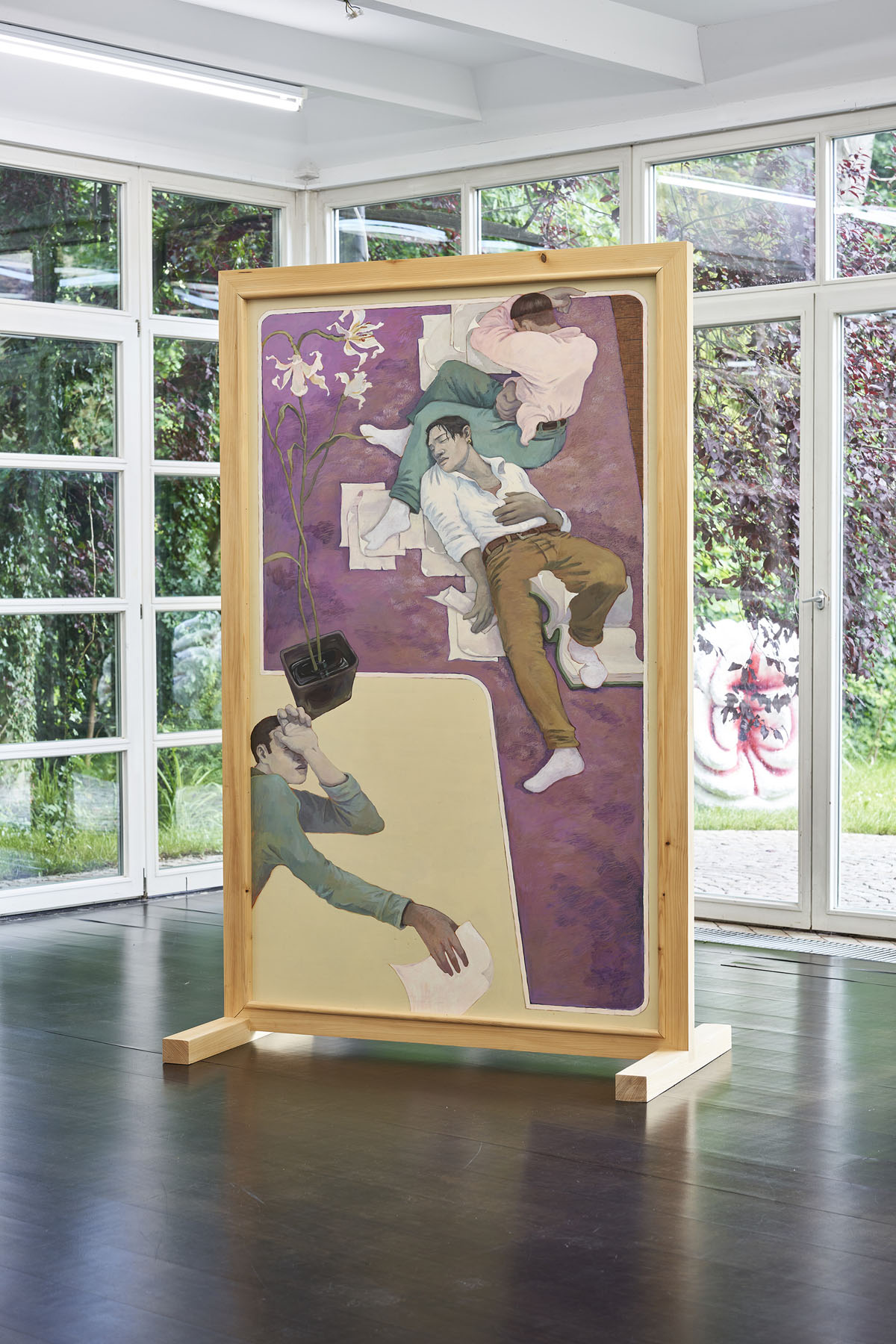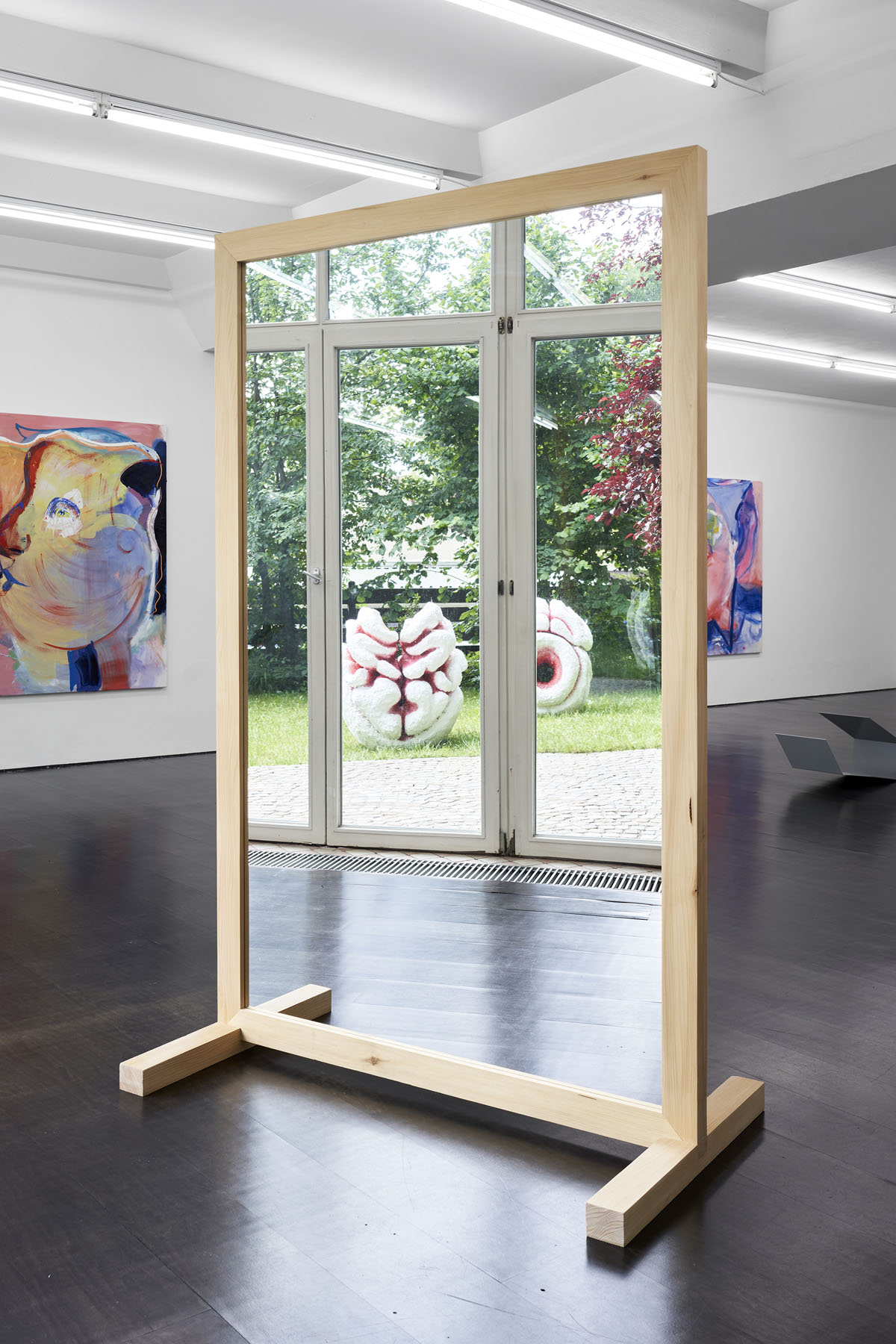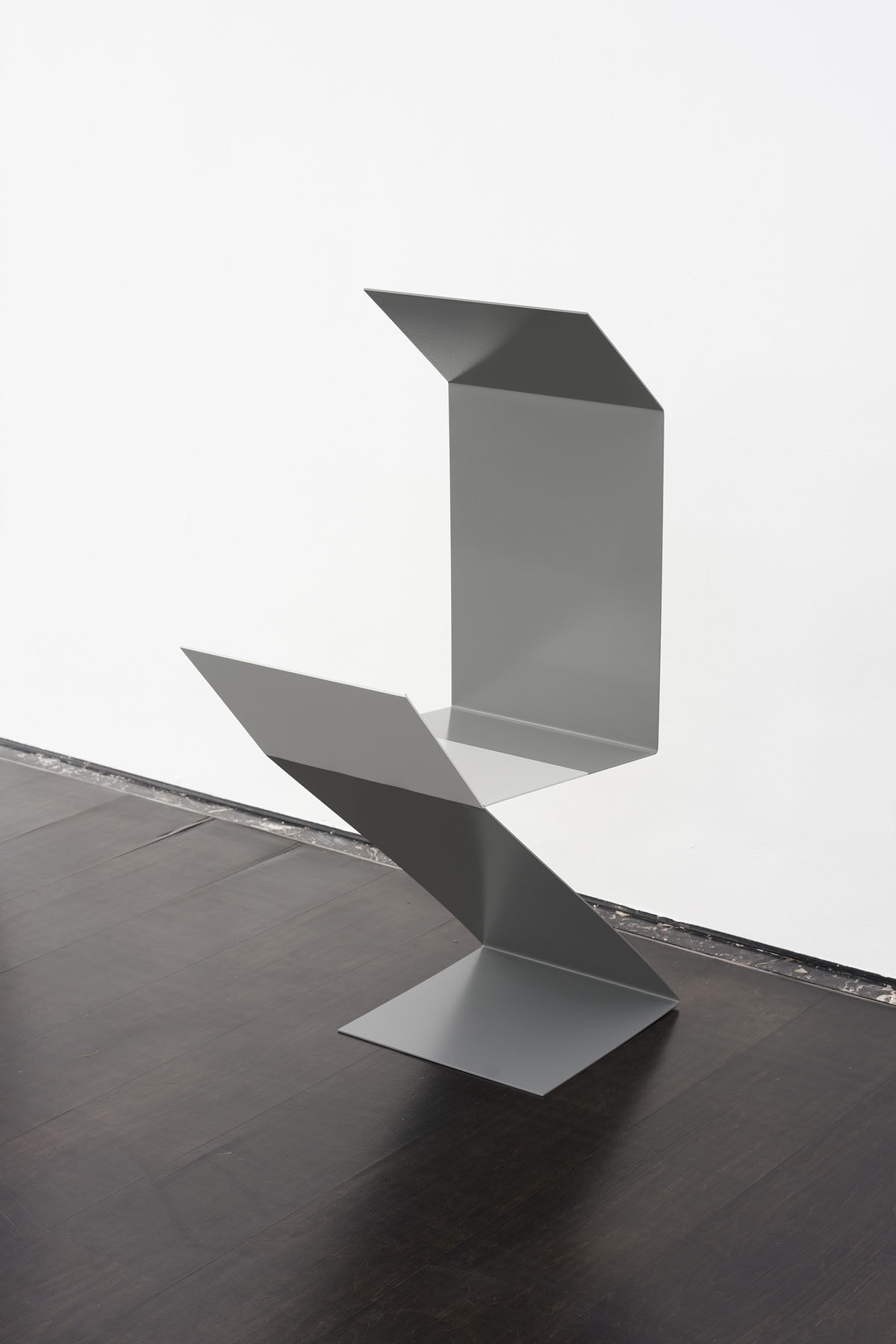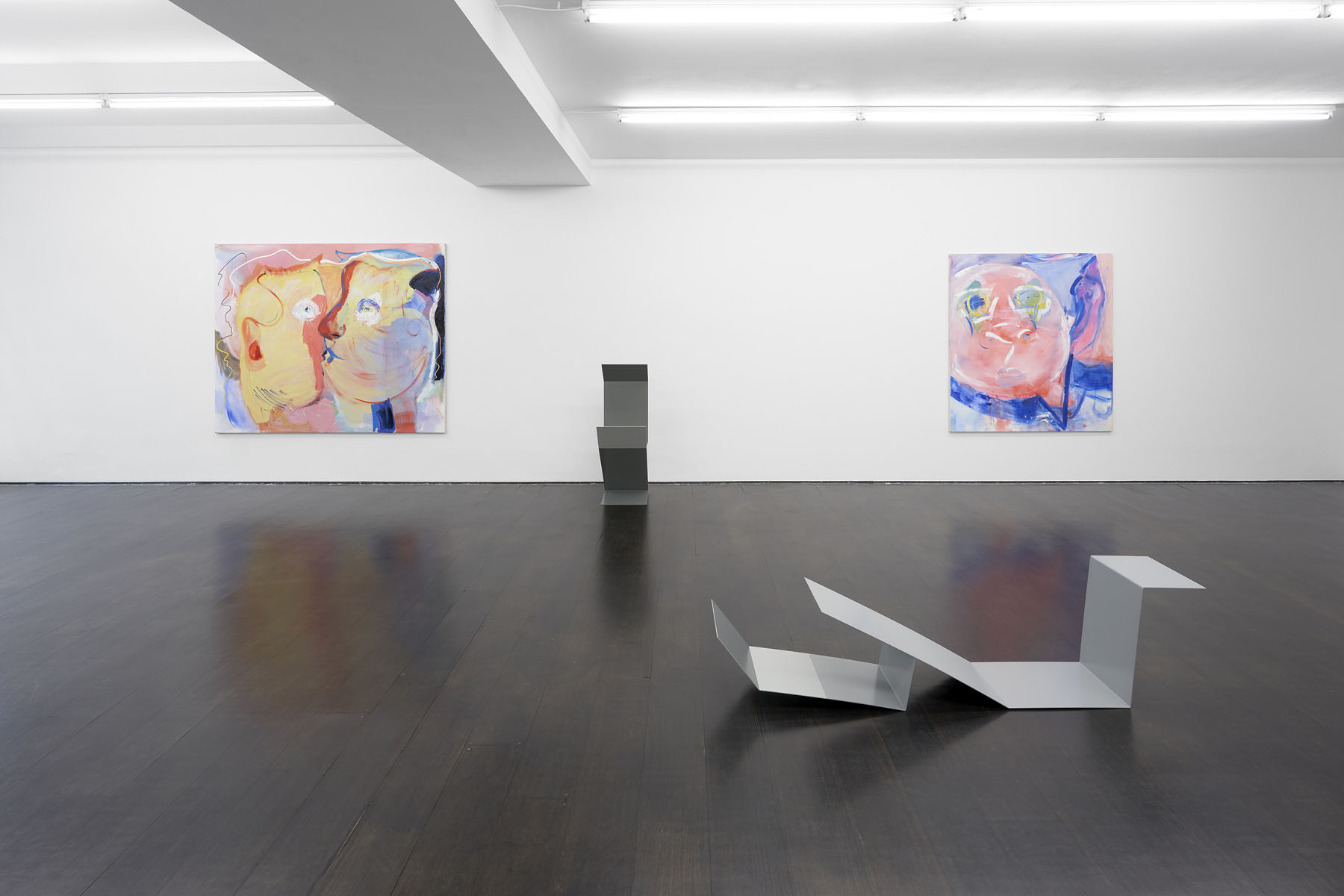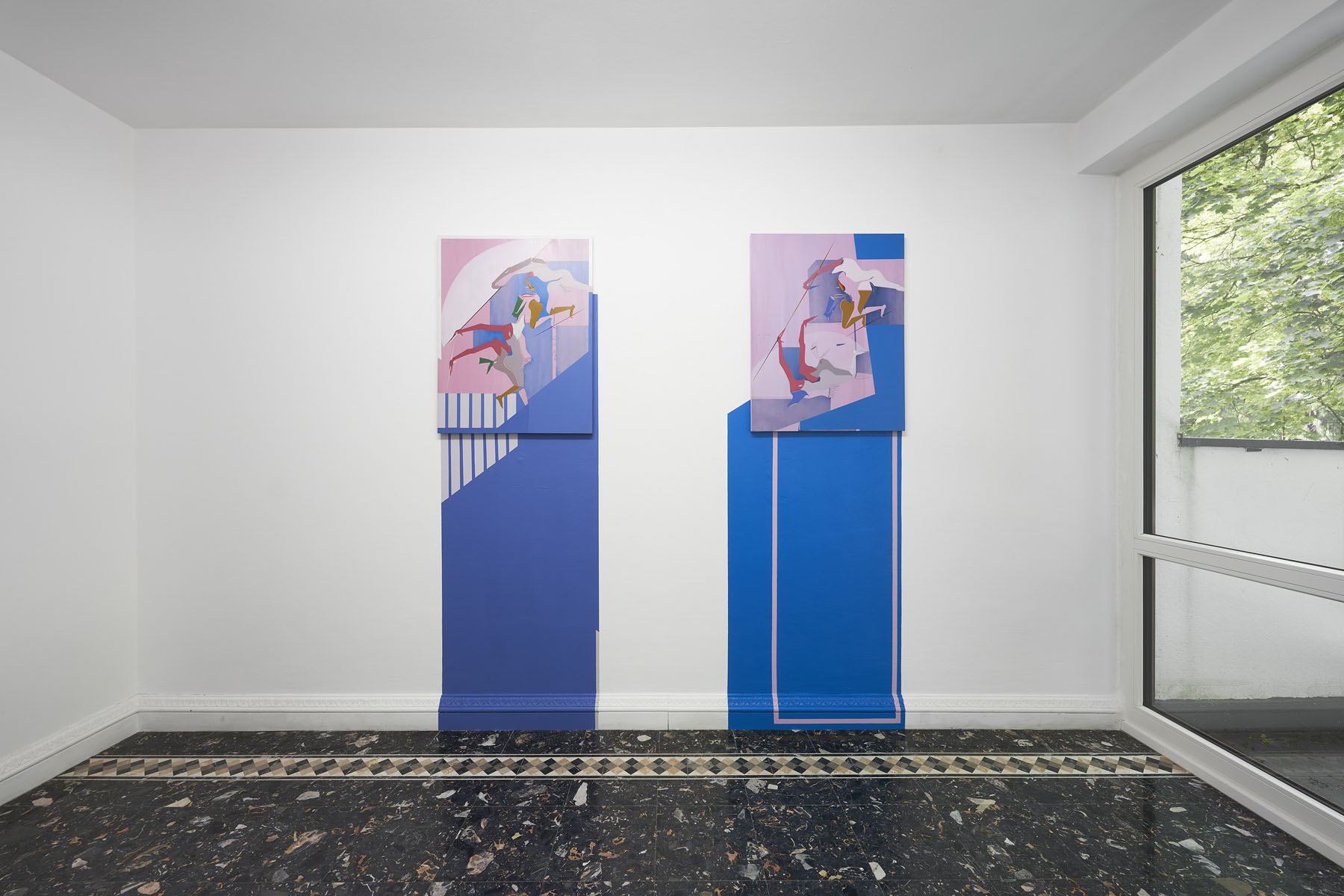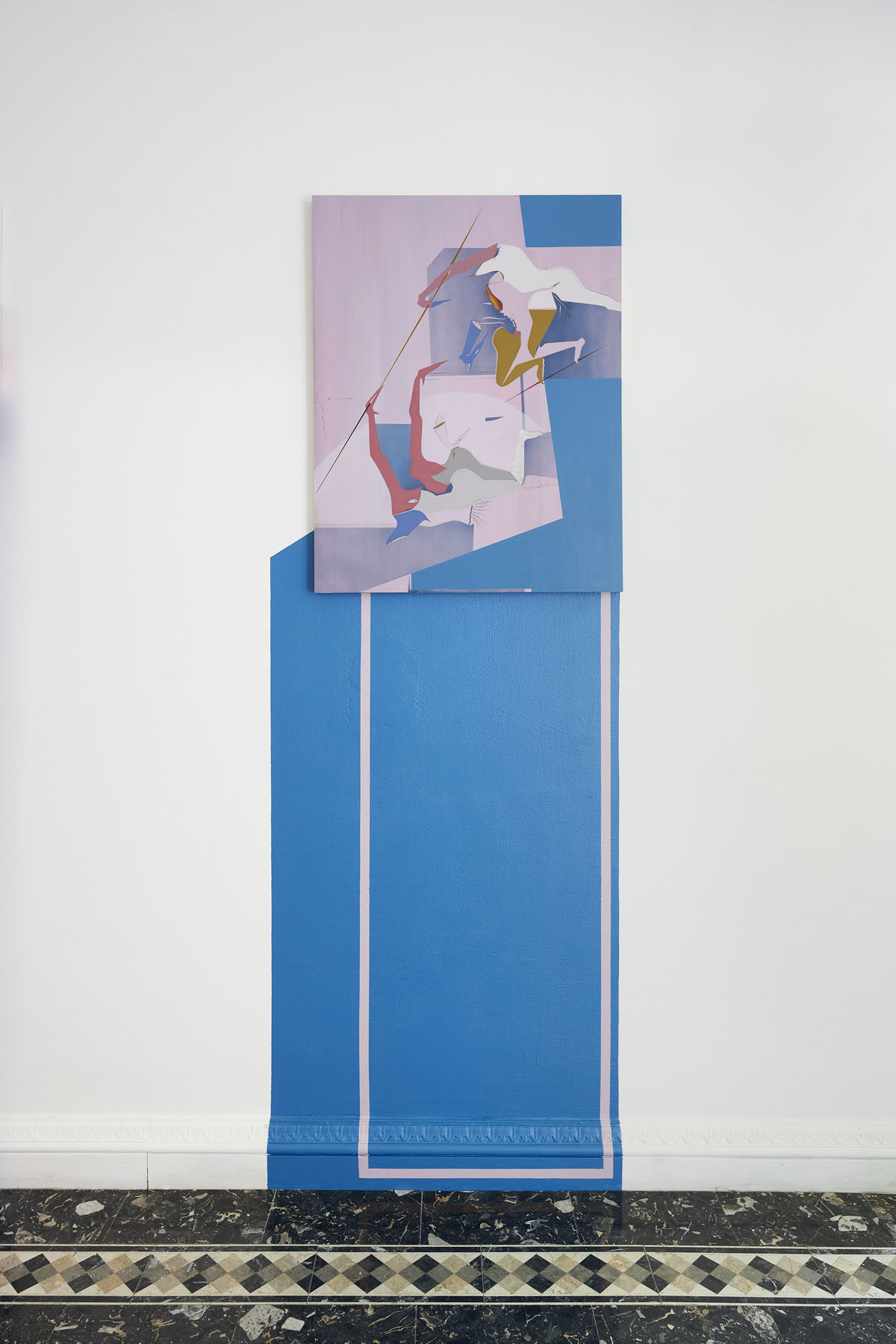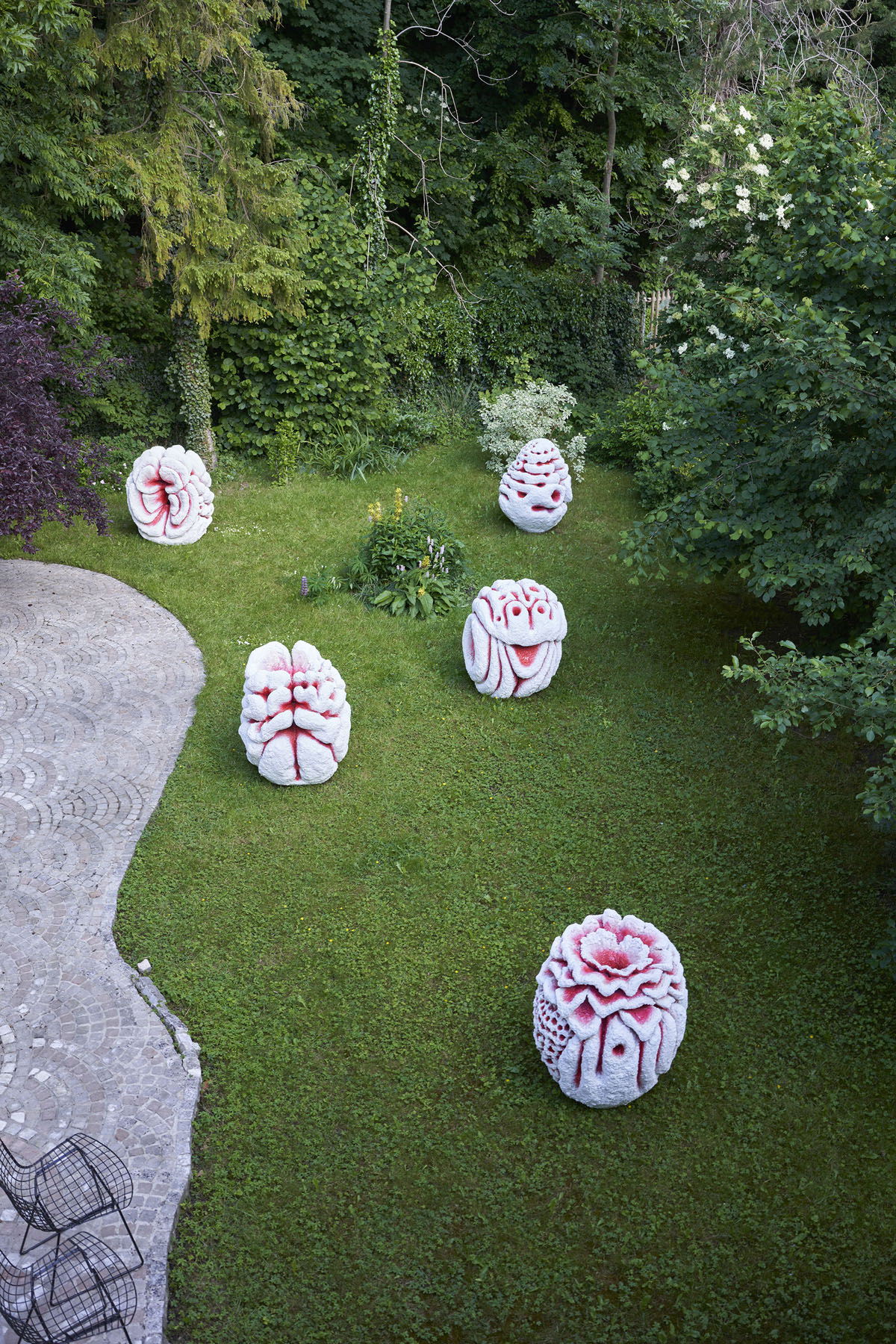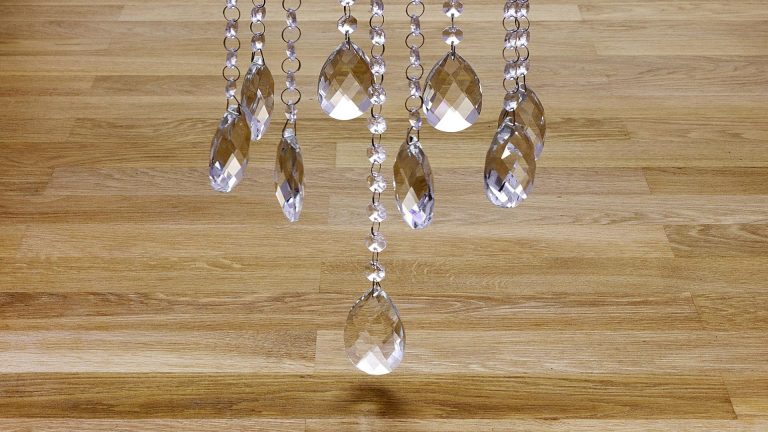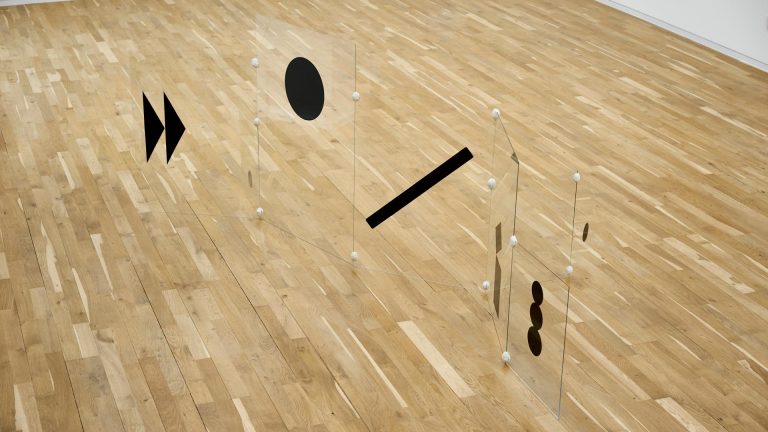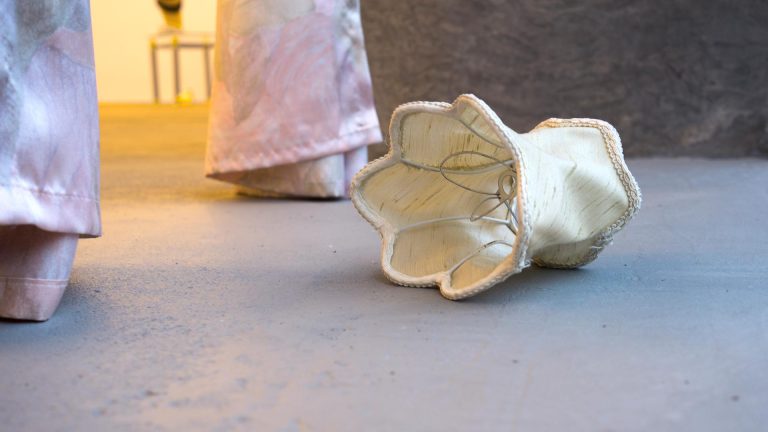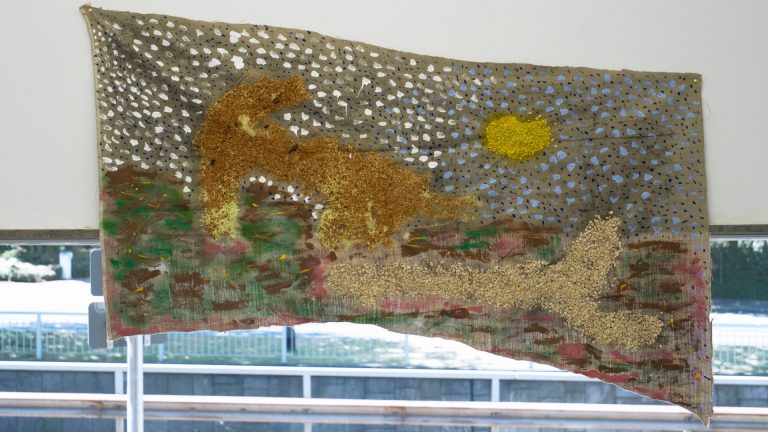Artists: Judith Hopf, Maryam Hoseini, Yong Xiang Li, Aileen Murphy, Eric Sidner, Amalia Ulman
Exhibition title: Fables of Resurrection
Venue: Deborah Schamoni, Munich, Germany
Date: May 28 – August 8, 2020
Photography: Ulrich Gebert, all images copyright and courtesy of the artists and Deborah Schamoni, Munich
The exhibition Fables of Resurrection manifests a kaleidoscopic snapshot of experiences that oscillate between arrest and an excess of agency. Conveying dreamlike states, the works in this exhibition weave together modes of storytelling to think about different relationships between the individual and social body.
Such a reflection on the interrelation between corporality and temporality may inevitably be read as one about the current “Virus-Time”: the replacement of an illusion of a common, global world with discontinuous and isolated realities; the provocation of “a temporality that’s not only plotless but has no end in sight.”1
Fables of Resurrection frames these experiences within economic deferrals that have promoted competition and risk instead of stability, security and compassion, and have intensified social asymmetries. Questions about political subjectivity and social transformation in particular draw on the often-romanticized role of art and the artist: what are the narrative potentials in the face of such overdetermined conditions?
The exhibition showcases new and seminal works by artists of the gallery Judith Hopf, Amalia Ulman, Eric Sidner and Aileen Murphy, as well as works by New York-based painter Maryam Hoseini and the Frankfurt-based artist Yong Xiang Li.
Amalia Ulman’s online performance Excellences & Perfections (2014) over the course of five months, continuously documented the evolution of a young woman in the age of social media, her daily self-mirroring and self-optimization. Sourcing found footage from the vast pool of images that the internet has to offer, and carefully reconstructing scenes of her ‚self‘, the artist spawned the story of a vulnerable girl, seeking good fortune in Los Angeles, where she undergoes a breast augmentation, meets a sugar daddy, suffers a drug addiction and after a breakdown eventually finds healing and happiness in avocado toasts and yoga. Ulman demonstrates the fragile threshold between staging and identity, and reality and fiction. She simultaneously questions the digital realm’s potential to drive societal transformation. That, particularly, in the face of its architectures of control and individualism, inciting the constant production and consumption of regulated and quantifiable pleasure.
Yong Xiang Li works in diverse media and tests out the intersections of painting, sculpture and video. Stylistically, Shirt Late (2018) references exotizising and erotizising potencies found in paintings of Fin de siècle interior scenes, foregrounding cultures’ double-edged role to consolidate, and, on the other hand, potentially disrupt oppressive power structures of representation. Within a larger than life sculptural wood frame three young men are depicted lingering, possibly sleeping, surrounded by blank books and pages. Their relation to each other and status is unclear: Are they resting in preparation or have they capitulated? On the other side of the frame, the act and space of viewing and interpretation is thrown back at us through a large mirror. The video work 金丝小调 (继 唐尼海瑟薇与卡彭特兄妹), Some Hair May Sing (A Song for You) (2019) imagines what would happen if the owner of a home is not in charge of the house anymore.
In her sculptures, videos and drawings, Judith Hopf addresses the politics of art making and the impact of visible and invisible architectures, technology and objects, on the human body and movements. Often sourced from everyday as well as modern and postmodern aesthetic vocabulary, her works challenge habituals views, representations and behaviors. The anthropomorphized Laptop Men (2018), which have already been shown in solo exhibitions at Kunstwerke Berlin and SMK – the National Gallery of Denmark, in particular, point to our relationship to computers and the tendency to increasingly view them as extensions of our bodies. Sitting, laying on the floor, leaning, the Laptop Men are immersed in their own worlds and thematize the changing way that we interact with each other in private and public space.
Aileen Murphy’s canvases are lurid and brassy with strong sweeping brush strokes that evoke activity and dance, in which bodies merge with each other and their surroundings. Her figures melt into many amorphous shapes, implying both corporeal and spiritual realms. As her paintings bounce between abstraction and figuration, the presence of bodies, and the artist’s own body is omnipresent and transport irrational, sometimes uneasy feelings. Paintings allow for contradictions to coexist in the same place and Murphy’s methodology embraces conflicting sensibilities of disobedience, care and desire.
Maryam Hoseini’s carefully constructed acrylic paintings with detailed pencil drawings create fictional stories that are built on visible and invisible ruins of architectures and histories. Her works ambiguously operate in the realm between representation and abstraction and depict the interrelation be-tween fragmented bodies and spaces, at once flattened out and in motion, as the collapse of the body and the background create unease. Hoseini is interested in the political, social, and personal conditions of the often-fractured construction of self. The headless bodies may manifest both a potential subversion and captivity in dynamics that categorize racial and sexual identities. They are bodies of anxiety, but, as Hoseini describes them, they are also full of strength. Hoseini’s works distinctively play with narrative and temporal openness. Ruins, they seem to suggest, can be built on collectively.
Eric Sidner’s work often grapples with the unconscious relation to popular culture and the way our relationships and identities are affected by passive absorption of visual in-formation. For the Heads series of psychedelic looking outdoor sculptures, the artist worked through a wide range of images of, amongst others, phenomena in nature that trigger trypophobia: an aversion to the sight of irregular patterns or clusters of small holes or bumps. With this sculptural series, inciting both repulsive and attracting effects, Sidner wants to point to way fear of the unknown and perceived threats to the symbolic order can, on individual and sociopolitical levels, lead to an irrational and often dangerous deferral of such phobias.
[1] John Kelsey “VIRUS-TIME”, Artforum, MAY/JUNE 2020, VOL. 58, NO. 9
Fables of Resurrection, 2020, exhibition view, Deborah Schamoni, Munich
Fables of Resurrection, 2020, exhibition view, Deborah Schamoni, Munich
Fables of Resurrection, 2020, exhibition view, Deborah Schamoni, Munich
Fables of Resurrection, 2020, exhibition view, Deborah Schamoni, Munich
Fables of Resurrection, 2020, exhibition view, Deborah Schamoni, Munich
Aileen Murphy, Falling, like a stone, 2020, Oil on canvas,160 x 200 cm
Fables of Resurrection, 2020, exhibition view, Deborah Schamoni, Munich
Judith Hopf, Untitled (Laptop Man 5), 2018, Powder-coated steel, 109 x 35 x 72 cm
Fables of Resurrection, 2020, exhibition view, Deborah Schamoni, Munich
Judith Hopf, Untitled (Latop Man 6), 2018, Powder-coated steel, 45 x 187 x 32 cm
Fables of Resurrection, 2020, exhibition view, Deborah Schamoni, Munich
Amalia Ulman, Excellences & Perfections (Instagram Update, 6th July 2014), C-Type print dry mounted on aluminium, mounted on black edge frame, 125 × 125 × 3 cm
Fables of Resurrection, 2020, exhibition view, Deborah Schamoni, Munich
Aileen Murphy, Birthday, 2020, Oil on canvas,150 x 140 cm
Fables of Resurrection, 2020, exhibition view, Deborah Schamoni, Munich
Fables of Resurrection, 2020, exhibition view, Deborah Schamoni, Munich
Yong Xiang Li, 金丝小调 (继唐尼海瑟薇与卡彭特兄妹), Some Hair May Sing (A Song for You), 2019, Single-channel video
Yong Xiang Li, 金丝小调 (继唐尼海瑟薇与卡彭特兄妹), Some Hair May Sing (A Song for You), 2019, Single-channel video
Fables of Resurrection, 2020, exhibition view, Deborah Schamoni, Munich
Fables of Resurrection, 2020, exhibition view, Deborah Schamoni, Munich
Fables of Resurrection, 2020, exhibition view, Deborah Schamoni, Munich
Maryam Hoseini, With Her Hand on Her Shadow 3, 2019, Acrylic, ink and pencil on wood panel, latex on wall, 81 x 63,5 cm, Overall: 203 x 76 cm
Maryam Hoseini, With Her Hand on Her Shadow 3, 2019, Acrylic, ink and pencil on wood panel, latex on wall, 81 x 63,5 cm, Overall: 203 x 76 cm
Maryam Hoseini, With Her Hand on Her Shadow 4, 2019, Acrylic, ink and pencil on wood panel, latex on wall, 81 x 63,5 cm, Overall: 203 x 76 cm
Maryam Hoseini, With Her Hand on Her Shadow 4, 2019, Acrylic, ink and pencil on wood panel, latex on wall, 81 x 63,5 cm, Overall: 203 x 76 cm
Maryam Hoseini, Twice in Battle, 2018, Acrylic, ink, nails and pencil on wood panel, 61 x 51 cm
Maryam Hoseini, Twice in Battle, 2018, Acrylic, ink, nails and pencil on wood panel, 61 x 51 cm
Maryam Hoseini, Liars Like To Fly, 2017, Acrylic, ink and pencil on wood panel, latex on wall, Overall: 182,88 × 56,52 cm, top panel: 60,96 × 50,80 cm
Maryam Hoseini, Liars Like To Fly, 2017, Acrylic, ink and pencil on wood panel, latex on wall, Overall: 182,88 × 56,52 cm, top panel: 60,96 × 50,80 cm
Maryam Hoseini, Liars Like To Fly, 2017, Acrylic, ink and pencil on wood panel, latex on wall, Overall: 182,88 × 56,52 cm, top panel: 60,96 × 50,80 cm
Fables of Resurrection, 2020, exhibition view, Deborah Schamoni, Munich
Fables of Resurrection, 2020, exhibition view, Deborah Schamoni, Munich
Fables of Resurrection, 2020, exhibition view, Deborah Schamoni, Munich
Eric Sidner, Heads 02, 2019, Styrofoam, plaster, epoxy resin, acrylic paint, plastic, 100 x 92 x 75 cm
Eric Sidner, Heads 03, 2019, Styrofoam, plaster, epoxy resin, acrylic paint, plastic, 106 x 100 x 80 cm
Eric Sidner, Heads 04, 2019, Styrofoam, plaster, epoxy resin, acrylic paint, plastic, 105 x 100 x 85 cm
Eric Sidner, Heads 01, 2019, Styrofoam, plaster, epoxy resin, acrylic paint, plastic, 100 x 90 x 70 cm
Eric Sidner, Heads 05, 2019, Styrofoam, plaster, epoxy resin, acrylic paint, plastic, 90 x 100 x 75 cm
Fables of Resurrection, 2020, exhibition view, Deborah Schamoni, Munich
Yong Xiang Li, 金丝小调 (继唐尼海瑟薇与卡彭特兄妹), Some Hair May Sing (A Song for You), 2019, Single-channel video

